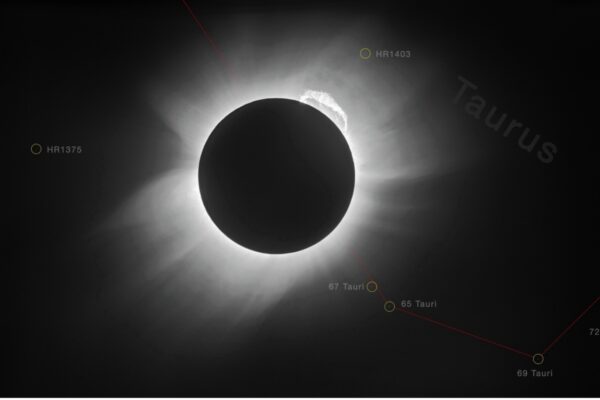In 1919 two British scientists conducted an experiment intended to verify Albert Einstein’s controversial theory of general relativity. This physical theory, that had been published four years prior, proposed the universe is four-dimensional and that massive objects like the sun actually warp the very fabric of spacetime. According to general relativity, this warped spacetime is what we feel as gravity.
Of course, Einstein’s theory was purely theoretical. So another physicist, Arthur Stanley Eddington, believed observing a total solar eclipse might support the validity of Einstein’s radical thesis. Since Einstein had predicted that gravity would bend the path of light near massive objects like the sun, curving spacetime itself, Eddington realized that during a total solar eclipse, the moon blocks the sun’s light, allowing stars near the sun to be visible. By photographing the positions of stars near the sun during the 1919 total solar eclipse, Eddington’s experiment proved to be a landmark result, helping establish general relativity as the prevailing theory of gravity over Sir Isaac Newton’s previous model.
Disprove Me Right!
Science is as much about disproving as it is proving hypotheses. Always looking for that fatal flaw in Einstein’s theory, several amateur and professional scientists sought to reproduce Eddington’s results in the coming decades. In fact, the last experiment conducted using photography was performed by a team from the U.S. Naval Observatory, Princeton University and UT Austin.
“I was actually on that team,” said Richard Matzner, professor of physics at UT’s College of Natural Sciences. “In 1973, myself and the rest of the group traveled to an area in Mauritania, Africa. There we witnessed a total solar eclipse that lasted for six minutes and 10 seconds, a very long time for an eclipse.”
Using improved visual photographic technology than what Eddington would’ve had at his disposal in 1919, Matzner and his colleagues found reasonable proof to corroborate Einstein’s theory once more.
Riding The Gravitational Wave
At UT Austin’s Center for Gravitational Physics, researchers are expanding on the pioneering work of Eddington and his team by helping to explore one of the other exciting predictions of Einstein’s theory of general relativity that observers were unable to verify for an entire century, namely, the existence of gravitational waves.
Simply put, these ripples in spacetime – caused after massive space events, such as two black holes colliding – are the messengers of gravitational information. In the same way electromagnetic radiation (light) provides us with information from the sun, we also get gravitational wave information from objects.
However, it took a long time for gravitational waves to be welcome at the spacetime party. “Gravitational waves were one of Einstein’s predictions that even he was uncomfortable with for a while,” said Deirdre Shoemaker, Director of the Center for Gravitational Physics.
Shoemaker is nonchalant when discussing gravitational waves. However, just a decade prior, they still hadn’t been directly confirmed as real.
It wasn’t until 2015, a century after Einstein even posed the hypothesis, that scientists would successfully find the requisite evidence. And the UT Austin theoretical physicist was part of the international team that confirmed their existence.
“The Laser Interferometer Gravitational-Wave Observatory, or LIGO project, (of which I am a member) is a large scientific collaboration involving many researchers across different universities and countries,” Shoemaker said. “In 2015, the LIGO’s detections were the first direct observations of gravitational waves.”
(In fact, Shoemaker isn’t the only UT Austin connection to what some described as “the biggest scientific discovery of our time.” The director of LIGO at the time they found the first-ever detection of gravitational waves, David Reitze, is an alumnus who started his career as a Ph.D. candidate at UT Austin.)
There are two LIGO observatories located in the United States – one in Washington and another in Louisiana. Each uses lasers and mirrors arranged in an “L” shape to precisely measure the distance between the mirrors.
Gravitational waves passing through the observatories cause tiny changes in the distances between the mirrors. By measuring any differences in the distances using the lasers, LIGO can detect these gravitational waves. This allows scientists to study cataclysmic events in the universe like black hole and neutron star collisions.
Black Hole Sun
Since total solar eclipses can only be seen about every 400 years from any one place on the surface of the Earth, Shoemaker studies gravitational waves by observing the more dependable black hole – also large enough to warp spacetime.
Choosing the empty nothingness of a black hole over the sun doesn’t appear to have been a compromise for the NSF Career award winner and fellow of the American Physical Society.
“Black holes are beautiful because they don’t contain any messy matter,” she said. “They’re just curved space time.”
And, since they can form in pairs, and even binary pairs that eventually merge into one bigger black hole, they are excellent sources of gravitational waves.
“Black holes are our strongest source,” said Shoemaker. “We see them with the detector all the time. We’ve observed almost 90 individual gravitational waves coming from black holes since 2015.”
Texas Sunsets Meet Their Match
Of course, one doesn’t need to retain any of the above information to enjoy the total solar eclipse on April 8, 2024. It will be just as spectacular to watch for the non expert as it will be for the most zealous of gravitational physicists.
But as Arthur S Eddington demonstrated over a century ago, the eclipse on April 8 is an opportunity for those now carrying the gravitational torch to find answers to other questions about our universe. You just have to know what to look for.




